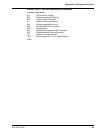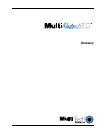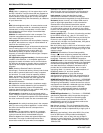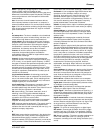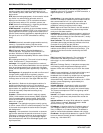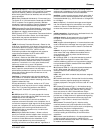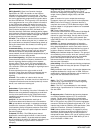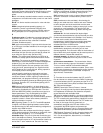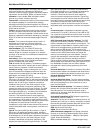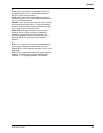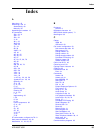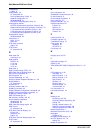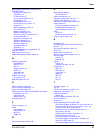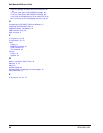
92
MultiModemISDN User Guide
MTA128ST-USB
telecommunication service—A function, such as bearer
service and teleservice, offered by an RPOA to its
customer in order to satisfy a specific telecommunications
requirement. See also ISDN, RPOA, and bearer service.
telematics—User-oriented ISDN information transfer
services (e.g., teletex, videotex, facsimile).
Teleservices—A telecommunications service that provides
the complete capability for communication between
subscribers according to protocols agreed to by RPOAs. A
set of ISDN features using communications links, including
E-Mail and fax services.
Teletext—A telecommunications service that provides a
one-way information retrieval service that uses unused
portions of a TV channel bandwidth. A fixed number of text
pages are repetitively broadcast for decoding by a decoder
at the TV set that can select and display pages. See also
ISDN.
terminal—The screen and keyboard device used in a
mainframe environment for interactive data entry.
Terminals have no box, which is to say they have no file
storage or processing capabilities.
terminal adapter (TA)—An ISDN DTE device for
connecting a non-ISDN terminal device to the ISDN
network. Similar to a protocol converter or an interface
converter, a TA connects a non-ISDN device between the
R and S interfaces.
tone dialing—One of two methods of dialing a telephone,
usually associated with Touch-Tone® (push button)
phones. Compare with pulse dialing.
TSR (terminate and stay resident)—A software program
that remains active and in memory after its user interface is
closed. Similar to a daemon in UNIX environments.
twisted pair wiring—A type of cabling with one or more
pairs of insulated wires wrapped around each other. An
inexpensive wiring method used for LAN and telephone
applications, also called UTP wiring.
Type A: The upstream (USB Type A) connector. A Type A
Connector is for those devices on which the external cable
is permanently attached. Connectors for USB come in two
designs: the 'A' and 'B' types. Upstream connections
(computer, hub input, etc.) are made using the 'A' type
connector, downstream connections (peripherals, hub
outputs) are made using the 'B' type connector. The USB
spec defines two types of connectors to protect the bus
from illegal topologies (e.g., connecting one downstream
port back to another, etc.) and to prevent end-user
confusion. This allows end users to easily attach the
correct connectors to peripherals and ports. Type A Plug
and receptacle are to be used for those devices on which
the external cable is permanently attached to devices such
as Keyboard, mouse and hubs. Series B Plug and
receptacle are to be used for those devices that require an
external detachable cable such as printers, scanners and
modems.
Type B: The uplink (USB Type B) connector. A Type B
Connector is for detachable external cables. Allows for
double ended cable assemblies. Connectors for USB come
in two designs: the 'A' and 'B' types. Upstream connections
(computer, hub input, etc.) are made using the 'A' type
connector, downstream connections (peripherals, hub
outputs) are made using the 'B' type connector. The USB
spec defines two types of connectors to protect the bus
from illegal topologies (e.g., connecting one downstream
port back to another, etc.) and to prevent end-user
confusion. This allows end users to easily attach the
correct connectors to peripherals and ports. Type A Plug
and receptacle are to be used for those devices on which
the external cable is permanently attached to devices such
as Keyboard, mouse and hubs. Series B Plug and
receptacle are used for devices that require an external
detachable cable such as printers, scanners and modems.
U
U reference point—A twisted-pair subscriber loop that
connects the LT to the NT1. Normally a 2-wire BRI or PRI
line is used, but a 4-wire BRI can also be used. In the US,
the U Reference Point marks the separation point between
CPE and the network.
UHCI (Universal Host Controller Interface): The USB
Universal Host Controller Interface. All transfers on the
USB are initiated by the host system’s host controller. The
host controller is responsible for controlling traffic on the
USB and can be appropriately programmed to transfer
data to and from USB devices. This is typically a PCI
device that can be programmed to run a given schedule of
transfers on the USB and bus master the results into
memory for processing by the host software. There are
currently two standards for host controllers: OpenHCI
(OHCI or Open Host Controller Interface) and UHCI
(Universal Host Controller Interface). Both these standards
define register level interfaces of the host controller to PCI
bus. Bandwidth allocation over the USB is software
managed and is done by the programming of the host
controller.
Universal Serial Bus: A collection of Universal Serial Bus
devices and the software and hardware that allow them to
connect the capabilities provided by functions to the host.
Universal Serial Bus Device: Includes hubs and
functions. See device.
Universal Serial Bus Driver: The host resident software
entity responsible for providing common services to clients
that are manipulating one or more functions on one or
more Host Controllers.
Universal Serial Bus Interface: The hardware interface
between the Universal Serial Bus cable and a Universal
Serial Bus device. This includes the protocol engine
required for all Universal Serial Bus devices to be able to
receive and send packets.
Unshielded Twisted Pair (UTP): Telephone-type wiring.
Tansmission media for 10Base-T.
Upstream: The direction of data flow towards the host. An
upstream port is the port on a device electrically closest to
the host that generates upstream data traffic from the hub.
Upstream ports receive downstream data traffic.
USB: See Universal Serial Bus.
USBD: See Universal Serial Bus Driver.
USB Performance categories: Low Speed (Interactive
Devices at 10-100 Kb/s); Medium Speed (Phone, Audio,
Compressed Video at 500Kb/s - 10Mbp/s); High Speed
(Video, Disk at 25-500 Mb/s)
UTP (unshielded twisted pair) —Telephone-type wiring.



